Leonard Brillson
Editor, INTERSECTIONS
Member, Government Affairs Committee
Welcome to our INTERSECTIONS Newsletter!
Since our last newsletter, Congress has begun work on appropriations legislation that would provide continued Federal support for our science and technology community in the absence of a budget agreement to avoid sequestration. The MRS Government Affairs Committee (GAC) aims to understand the associated changes in legislative policy environment and its impact on materials research.
GAC Chair, David Norton highlights the importance of materials research in our quality of life, especially under extreme conditions encountered in space as well as here on earth.
Our MRS Washington consultant, Damon Dozier describes the challenges facing Congress in providing steady funding for Federal agencies that materials researchers depend on while dealing with budget caps.
Our Grassroots Subcommittee Chair, Boris Dyatkin describes the negative impact of this winter’s partial government shutdown on government researchers and our messaging campaign to legislators to avoid future shutdowns.
Jennifer Nekuda Malik, Chair of the Advocacy Engagement Subcommittee, describes new projects to highlight materials research success stories and to create a website update for MRS government affairs.
Our Congressional Fellowship Program Chair, Ashley White describes the MRS Congressional Science and Engineering Fellows program and the activities of our current Fellows.
Bill Hammetter, our Congressional Visits Day Chair, describes how our MRS Member teams visited offices of over three dozen Senators and Congressional Representatives to brief them on issues important to the MRS community and request sustained funding levels for key science and technology agencies.
Government Agencies Subcommittee Chair, Diogenes (Dio) Placencia describes MRS-sponsored activities for interacting with Federal agency representatives about funding opportunities, as well as, participating in materials research meetings internationally.
Finally, Gene Fitzgerald’s INTERSECTIONS article on value- added materials science in this issue features yet another success story, highlighting how Federal investments in materials science pay off in ways that the public and especially our elected officials can relate to.
Government Affairs Committee Chair
 David Norton
David Norton
Chair, Government Affairs Committee
The MRS Spring Meeting in Phoenix was excellent this year, with terrific symposia, great speakers, and lots of sunshine. Whenever I visit Phoenix for the Spring Meeting, I am always thankful that it is not in July, but equally fascinated at how the building infrastructure in Phoenix effectively functions and withstands the extreme heat of the desert summers. The importance of materials science in extreme conditions extends well beyond the streets of Arizona, playing a dominant role in technologies for transportation, energy, manufacturing, and in space. The recent emphasis in Washington, DC on space-based defense assets, highlighted within the “US Space Force” proposal, brings to the forefront the continued importance of materials research in extreme environments. New challenges emerge when considering the impacts of high- energy radiation, as well as thermal and mechanical stresses seen in launch and deployment.
Material properties in these extreme environments will significantly influence technology performance and outcome. So whether we are considering technologies at home, at work, or in the cosmos, materials research, largely supported by government agencies, continues to impact our daily lives, setting the stage for next generation technologies and innovations whether home is in the frigid elevations of the Rockies or the heat in the desert.
What's Happening in Washington
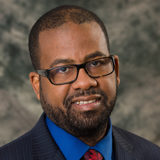 Damon Dozier
Damon Dozier
MRS Director of Government Affairs
At the beginning of the spring season, Congress has begun work on appropriations legislation – in the absence of a budget agreement that would raise statutory spending caps and avoid a scenario where sequestration would go into effect. As of press time, Congress and the Administration are scheduled to begin talks in the coming days on a budget deal and raising the debt ceiling, but a fight could hobble an accord on 2020 spending once again over border wall funding. According to reports, all parties are eager to avoid a repeat of the fiscal 2019 budget debacle that came after President Trump refused to sign spending bills without wall funding. In that instance, Democrats refused to accommodate Trump and a month-long partial government shutdown ensued. Congressional leadership will meet with top White House officials to talk about budget caps, and must come up with a compromise on lifting spending caps that would otherwise be imposed under the 2011 Budget Control Act (BCA). They will also discuss raising the debt ceiling. Democrats and Republicans are seeking a two-year deal to lift the caps, which will allow them to jump-start the process of passing legislation to fund the 2020 fiscal year. The talks are not expected to center on wall funding but could include a plan to raise the nation’s borrowing limit, which must be lifted in the next few months. Unless the White House and Congress act, the BCA caps will have a devastating impact on important research areas by arbitrarily cutting approximately $225 billion from the discretionary budget during the next two years. Recently, the Administration proposed a $4.7 trillion budget for next year, and it would make significant cuts to domestic spending, including the National Science Foundation, the Department of Energy and the National Institute of Standards and Technology. It also includes $8.6 billion to finish more sections of the border wall with Mexico – a significant issue contributing to last year’s government shutdown. On March 19, MRS issued a Statement on the Administration Budget Proposal for FY 2020, and you may view it on our Advocacy-Issues webpage.
While these issues have been going on, the House Appropriations Committee is continuing to release its spending bills for fiscal year 2020, with three subcommittees having completed their proposals: the Energy-Water Subcommittee, which oversees spending on the Department of Energy; the Defense Subcommittee, which has jurisdiction over Defense Department R&D programs; and the Interior-Environment Subcommittee, which handles the Environmental Protection Agency and U.S. Geological Survey, among other agencies. The full committee has already approved spending increases for each of these subcommittees, though final funding amounts will ultimately hinge on negotiations with the Senate.
Recently, Senator Martin Heinrich (D-NM), introduced the Artificial Intelligence Initiative Act, a bill that would organize a coordinated national strategy for developing Artificial Intelligence (AI) and to provide the necessary federal investment to build an AI-ready workforce and accelerate the responsible delivery of AI applications. The bill outlines these efforts similar to the recently passed National Quantum Initiative Act – just for AI. The legislation is designed bolster research, development, and application of AI in a coordinated way across government agencies, academia, and the private sector for at least the next ten years. According to the bill’s sponsor, the two pillars of this bill are 1) planning and coordination of AI research & development across the government, and 2) providing the resources necessary to the National Institute of Standards and Technology (NIST), the National Science Foundation (NSF), and the Department of Energy (DOE) to advance AI research, development, and lifelong education. The bill would invest a total of $1.475 billion over the next five years. The specific actions this bill proposes are:
- Directing NIST to outreach to stakeholders on the topic of standards for AI science and technology, including on topics such as safety, responsibility, and security. NIST shall identify metrics that may be used to establish standards for evaluating AI algorithms and their effectiveness, as well as the quality of training data sets.
- Requiring NSF to formulate educational goals for addressing algorithm accountability, explain ability, data bias, privacy as well as societal and ethical implications of AI. NSF will also fund research on both the technical and educational aspects of AI and its effect on our society through awarding up to five new “Multidisciplinary Centers for Artificial Intelligence Research and Education.”
- Tasking the Department of Energy to create an AI research program, building state-of-the-art computing facilities that will be made available first to government and academic AI researchers, but will also be available to private sector users on a cost-recovery basis as practicable. The bill will establish up to five Artificial Intelligence Research Centers to include institutions of higher education and national laboratories.
Overall, it looks like it will be a busy spring and summer on Capitol Hill. If you have any comments on this article, or would like to learn how to become involved in the government affairs activities of MRS, please send an email to [email protected]
Grassroots Subcommittee Chair News
 Boris Dyatkin
Boris Dyatkin
Chair, Grassroots Subcommittee
The Grassroots Subcommittee continues to keep its hand on the pulse of national events that affect the status of materials research in the United States. This was particularly evident during the 2018-2019 partial government shutdown, when thousands of federally employed scientific researchers lost their income and access to work, user facilities at NIST shuttered their doors, and the research grant process came to a screeching halt. We raised awareness amongst our members and warned materials scientists nationwide about the precarious state of research.
We continued this important messaging campaign during the 2019 MRS Spring Meeting in Phoenix, where conference attendees sent letters to their respective legislators and urged them to avoid any future repeats of this situation. Through the Materials Voice campaign, we, alongside our members, also reinforced the importance of sustained funding for key materials funding agencies – NIST, DOD, DOE, NIH, and NSF. Finally, the Grassroots Subcommittee highlighted the results of the Decadal Survey that had been recently completed by the National Academy of Sciences. The report outlines important avenues for pragmatic materials research policy, and both our legislators and our members must become informed regarding the survey’s takeaways.
With the summer months rapidly approaching, and visible legislative activity on Capitol Hill seemingly taking a backseat, our grassroots efforts are incredibly critical right now. For every news headline that dissects an emerging non-science legislative story, scores of staffers in the U.S. House and Senate are actively working on appropriations bills that will define the material science funding capability of our nation. In four months – September 30 – the fiscal year will end, and new appropriations and authorizations legislation must come into light. We are fully aware of the potential consequences of our government’s failure to do so--another disastrous shutdown. Our continued advocacy action continues to reach the ears of Congress and the President, and is our best political mechanism that reminds politicians of the significance of materials research funding.
Advocacy Engagement—Our Newest Initiative
 Jennifer Nekuda Malik
Jennifer Nekuda Malik
Chair, Advocacy Engagement Subcommittee
Over the last few months, the Advocacy Engagement Subcommittee has recruited members and started to better define its role. One of the goals is to engage a broad spectrum of members in advocacy, and our recruitment efforts have reflected that. With current subcommittee members hailing from academia, industry, and government, and spanning from student to well-established career researchers, the diversity of committee members has helped inform our efforts.
Two new projects are currently underway within the AE Subcommittee. The first is to generate materials research success stories that can be used for advocacy efforts. Four stories—covering energy efficiency gains realized through LED lighting, materials advances for power electronics, diamond-like carbon coatings to increase performance and durability of a range of manufactured parts, and the energy and materials savings associated with additive manufacturing—were written and included in the materials handed out during the Spring 2019 MRS Congressional Visits Days. These success stories were well received on the Hill and based on feedback from staffers and CVD volunteers; we are working to revise these and start to generate more for the next CVD.
The second project getting underway on the AE Subcommittee is a website update for MRS government affairs. Look for more information on this project in the next quarter!
Lastly, the AE Subcommittee also oversees the Congressional Fellowship program, which has successfully completed selection for the upcoming 2019-2020 Fellowship year. Further details on the selection process and fellows can be found in Ashley White's article.
MRS Congressional Science & Engineering Fellowship Corner
 Ashley White
Ashley White
Chair, Congressional Fellowship Program
The Congressional Fellowship selection committee completed its selection process for the 2019– 2020 MRS Congressional Science and Engineering Fellows earlier this spring. Stay tuned for a separate announcement about our new incoming Fellows, who will enter the program at the beginning of September, starting with our traditional welcome breakfast with former MRS Congressional Fellows and a few members of the GAC. After that, they will join a host of science and technology policy fellows sponsored by other professional societies for a two-week orientation provided by the American Association for the Advancement of Science, after which they will undergo a placement process that will determine the personal office or committee they will join for their fellowship year.
At the 2019 MRS Spring Meeting in Phoenix, the GAC sponsored its traditional Congressional Fellowship information session. These sessions, which MRS has held at both the Fall and Spring MRS Meetings for several years, provide an overview of the fellowship program to potential applicants and serve as a forum for questions and answers. Many fellowship applicants cite these info sessions as their introduction to the program. Please direct any potential applicants, at all career stages, to these information sessions or to the MRS Fellowship web page.
Our current 2018–2019 MRS Congressional Fellows, Dylan Rittman (MRS/OSA) and Michele Bustamante (MRS/TMS), are entering the final quarter of their fellowship year, working in the offices of Senator Kirsten Gillibrand (D-NY) and Senator Edward J. Markey (D-MA), respectively. Stay tuned for an update as they finish their fellowships and continue their careers.
Spring Congressional Visits Day
 William (Bill) Hammetter
William (Bill) Hammetter
Chair, Congressional Visits Day Subcommittee
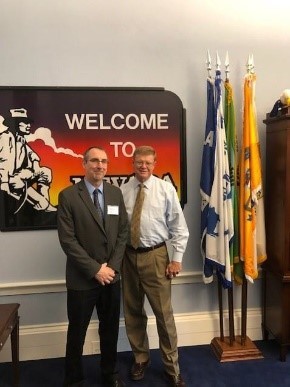
Sean Casey with Representative, Mark Amodei (NV)
|
April 1, 2019, what a great day to be in our Nation’s Capital preparing for the Materials Research Society’s Spring 2019 Congressional Visits Day. Eighteen MRS members traveled to Washington, D.C. complete with stories about how federal support of fundamental scientific research enhances the national enterprise, especially within these member’s home districts. In addition, Damon Dozier, the MRS Director of Government Affairs, gave an outstanding briefing on scientific issues important to the MRS community, the current budget situation especially the lifting of non- defense discretionary budget caps for 2020, and why the MRS is asking for specific levels of funding for The National Science Foundation, The Department of Energy Office of Science, The Department of Defense (6.1, 6.2, and 6.3), The National Institute of Standards and Technology, and NIBIB of The National Institutes of Health. Then, on April 2, these 18 MRS members, split into six “teams,” and armed with appropriate information, background and leave-behind documents for each office, made the trek to Capitol Hill to visit 41 offices of targeted Senators and Congressional Representatives. In general, our message was well received. Although we heard no “promises,” we believe that federal support for fundamental science research is viewed as an important asset of our nation, and that continued funding, within budgetary constraints, is a continuing priority.
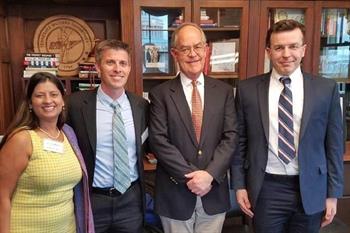
Jyoti Malhotra, Josh Caldwell and Stefanos Papanikolou with Representative, Jim Cooper (TN)
|
These congressional visits have been a continuing activity of the MRS Government Affairs Committee for many years. Our goal is to target Senate and Congressional appropriators, key members of Committees that oversee traditional funding of scientific research, legislative leaders and new members of Congress for visits by MRS members who are constituents of these legislators. Our goal is to remind these lawmakers that investments in research and development have an excellent return for the economy, the security of our nation, and improving the quality of life.
As always, special thanks to Donna Gillespie at MRS headquarters, and Damon Dozier, in Washington, D.C. for their support of this activity.
2019 MRS Spring Meeting—Your Government Agency Fall Meeting Feedback Pays Off

Diogenes (Dio) Placencia
Chair, Government Agency Subcommittee
Dear Members:
The Government Agencies Subcommittee sends you and your families’ warm greetings, and hope that it has been a productive year so far. With half of the year fast approaching, it is worth taking into account the many opportunities that exist for interacting with funding sources throughout the MRS, both nationally and internationally. In addition to our Spring and Fall Meetings, the MRS also supports several other activities such as the African MRS Meeting (AMRS), which is held every other year in specific sub-Saharan countries, and the International Materials Research Congress (IMRC), a joint Meeting between the Mexican Society for Materials (SMM) and MRS.
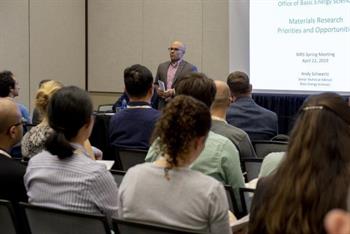
Dio introduces the information session
|
As the committee has shifted part of its focus to the international arena, due to the ever-increasing population of international researchers within the society, it has tried to find ways to bring these interactions outside of our U.S.-centric meetings.
As an example, let us look at the two Meetings discussed above. The IMRC held in Cancun, Mexico, every August has the largest share of materials researchers from across Latin America in attendance, with a significant population of international researchers participating. Research focusing under most aspects of materials science is covered, therefore creating a healthy population of potential researchers for Program Officers to interact with throughout their participation. As a committee, we have now started to “normalize” the Research Funding Opportunities session within this Meeting, which brings Program Offices such as the NSF, DoD, UC-Mexico Program, EU, and hopefully others to interact with the materials community. This year will be the second instance where we run this session, which is back by popular demand. At the African-MRS Meeting (slated for December 2019), the MRS is working with agencies to provide funding to potentially develop this type of session in the future. With enough effort on the committee side, along with government agencies participation (national and international), we can expand further the opportunities for Members to interact with research funding decision makers.
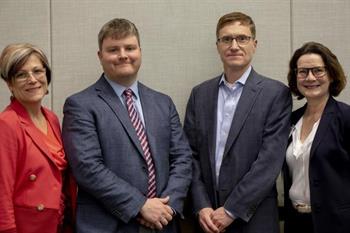
Linda Sapochak (NSF-DMR), Matt Baur (DOE-SETO), Andy Schwartz (DOE-Office of Science), and Mary Kavanagh (European Union)
|
Therefore, as materials research begins to take a more international flavor (diversification is always good!), our Subcommittee is trying to do its part to bring the funding sources to members across our national and international arenas. Truth be told, there are good research ideas across the globe, along with funding for these ideas; and our subcommittee is trying to do its part by connecting you, the members, to these sources. As always, we are open to feedback so never hesitate to reach out directly. Until next time.
A Value-Added Materials Research Story—Materials Research: A Foundation for Fundamental Innovation

E. A. Fitzgerald
Professor, Massachusetts Institute of Technology
CEO and Director, SMART (MIT's Research Enterprise, Singapore)
Economic growth is, properly, one of the central goals of communities around the world. Such growth lifts the standard of living, leading to better prosperity, something we all aspire to for our fellow human beings. Prolonged global growth is connected to waves of innovation, sometimes named after the operating paradigms, such as the industrial age and the information age. These waves of innovation have been connected to our understanding and subsequent engineering of materials and the processes that build them into the foundation of these paradigms.
We tend to think, in a shallow way, of the latest efficiencies introduced by software applications that further advance our connectivity through the internet, yet these pervasive more short-term innovations are built on top of the internet, built with wireless, optical, and other high-speed communication technology, which are built on top of a myriad of fundamental materials and processes advances that were decades in the making.
Decades of economic growth from the deployment of these fundamental materials advances ‘underneath’ our last wave of software efficiency far outweigh the economic growth in recent times; some estimates show that computers and electronics markets grew at more than 700% of the average growth rate in the US from the ‘80’s to 2010; basically, computers and electronics were the main driver of new growth in the US economy over this time period.
Prolonged economic success from prolonged long-term investment in materials research has, ironically, created an environment in which many have no connection to the real source of such growth. When the benefits of Moore’s Law (the techno-economic hind-sight observation that the paradigm increases transistor density in manufacturing in a power law with time) quietly lifts the livelihood of all, we have assumed that exponential efficiency of underlying materials advancements continues forever, without the need of long term investment. Moore’s Law was a quiet engine supplying us with fantastic growth allowing an industrial supply chain to be entirely re-created every couple of years, from materials up to cell phones, computers, and internet boxes. I was fortunate to be involved with a materials advance, strained silicon, that myself and co- workers invented and commercialized through a start-up company called Amberwave Systems Corporation in the late ‘90’s and early ‘00s. This advance allowed Moore’s Law to continue until recently, all the time mending the materials of the information age on the fly while growth was allowed to continue.
The strained silicon advance originated from an initial materials question: can lattice-mismatched semiconductor materials be useful? At the beginning, we investigated how dislocations nucleated and propagated when one semiconductor with a larger lattice constant is deposited on a semiconductor with a smaller lattice-mismatch. At one point, it took us six months to determine a viable method for counting the threading dislocations in such a structure. Being able to determine the exact dislocation density threading through the layer was key to understanding the nucleation vs. propagation question, and ultimately we needed to be able to measure what we wanted to engineer out of the structure. These investigations led to a variety of methods to eliminate dislocations in these structures, from patterned growth to high aspect ratio growth to composition graded layers. These techniques now form a complete toolbox when innovating in lattice-mismatched semiconductors that have now penetrated additional markets beyond silicon.
The materials research and innovation accomplished for lattice-mismatched materials then spread to other application areas. Professor, Steve Ringel from OSU was a long-term collaborator, and we leveraged the previous lattice-mismatch work as a foundation in creating the first high efficiency GaAs solar cell on silicon. New materials science problems emerged, such as perfecting heterovalent but lattice-matched interfaces like GaAs on Ge/Si. With new solutions in hand from further materials research, Steve and I formed a start-up, 4Power LLC, to commercialize high efficiency solar cells on silicon for lower cost power in the aerospace markets.
The growing applications of lattice-mismatched research continue onward today. With the ability to engineer III-V materials on silicon, we are now fabricating innovative integrated circuits with III-V devices directly inserted into silicon integrated circuit flows, potentially starting new growth areas in a static silicon picture at the end of Moore’s Law. The drive to create novel circuits introduced new levels of materials, device, and circuit research that needed to be solved, and now our new start-up, New Silicon Corporation, will lead us into a new generation of silicon integrated circuits.
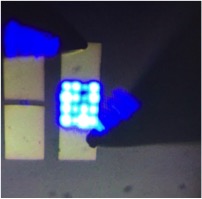
GaN LED array on silicon fabricated in a commercial silicon foundry.
|
What fundamental materials research will lead to waves of economic growth in the future? We do not know; there is no obvious paradigm operating at the moment, suggesting that we need to up our game, increasing our rate of investigations but at the same time performing more efficient research and innovation than we have in the past. Two obvious directions are future integrated circuits and systems (as we are taking one strategy mentioned above) and designing materials, devices, and systems for health. With Moore’s Law ending, the most exciting question in many decades is--what are the future integrated circuits of value? And, how will we build them? Regarding health, the main question always relates to designing and making materials and devices in a system that we did not build (a human) and how to unravel the complexity of this system so innovation efficiency can increase. In these challenges, it is insufficient to perform research in isolation, as the complexity of these problems needs to be shaped by innovation process as research unfolds.
We are in times of great uncertainty, but the other side of the coin is opportunity. Long-term efficient fundamental innovation research in materials is undoubtedly the key to exciting and necessary growth in the future, and materials advances will continue to create prosperity and health for all of us.
Feedback
You are receiving this newsletter as a subscriber to
Advocacy, or because of your participation in our
Materials Voice letter-writing campaigns. We welcome your feedback and invite you to submit topics for consideration in future issues of this newsletter. A complete PDF version is available at
www.mrs.org/INTERSECTIONS.
If you have or know of stories that illustrate how an investment in materials research paid off in real dollar terms, please send your suggestions to
INTERSECTIONS Editor, Len Brillson, at
[email protected]. Please send your
comments here.
Not a current MRS Member? It’s never too late to
join or renew. Plus, MRS Membership is included in registration for MRS Meetings.
Sign up for newsletters and alerts by visiting
www.mrs.org/alerts, or become a registered user and be sure to select Advocacy to continue receiving this quarterly newsletter.